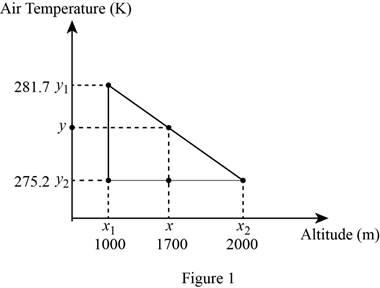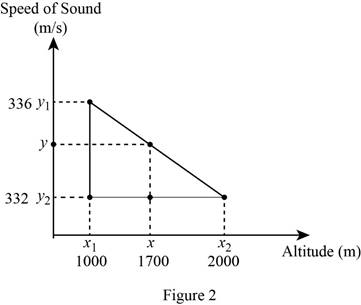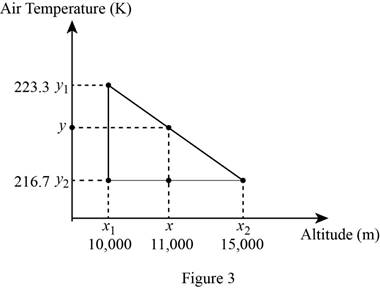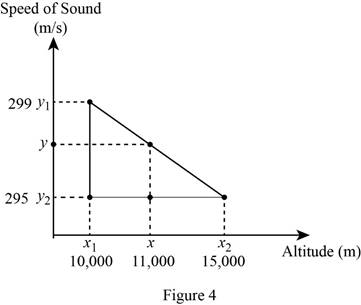
Concept explainers
Estimate the air temperatures and corresponding speeds of sound at altitudes of
Answer to Problem 35P
The air temperatures and corresponding speeds of sound at altitudes of
Explanation of Solution
Given data:
Refer to Table given in problem 18.35 in textbook,
The air temperature at altitude
The air temperature at altitude
The speed of sound at altitude
The speed of sound at altitude
The air temperature at altitude
The air temperature at altitude
The speed of sound at altitude
The speed of sound at altitude
Formula used:
Formula for the linear interpolation is,
Calculation:
To find the air temperature at altitude
The diagrammatic representation for the given value is drawn below,

Substitute
Equation (2) can be reduced as follows,
Reduce the equation as follows,
Therefore, the air temperature at an altitude
To find the speed of sound at an altitude
The diagrammatic representation for the given value is drawn below,

Substitute
Equation (3) can be reduced as follows,
Reduce the equation as,
Therefore, the approximate value of speed of sound at an altitude
To find the air temperature at altitude
The diagrammatic representation for the given value is drawn below,

Substitute
Equation (4) can be reduced as follows
Reduce the equation as follows,
Therefore, the air temperature at an altitude
To find the speed of sound at an altitude
The diagrammatic representation for the given value is drawn below,

Substitute
Equation (5) can be reduced as follows
Reduce the equation as follows,
Therefore, the approximate value of speed of sound at an altitude
Conclusion:
Thus, the air temperatures and corresponding speeds of sound at altitudes of
Want to see more full solutions like this?
Chapter 18 Solutions
LMS Integrated for MindTap Engineering, 2 terms (12 months) Printed Access Card for Moavni's Engineering Fundamentals: An Introduction to Engineering, 5th
- Planning is underway for the construction of a new railway section between Stockholm and Uppsala as part of the "Fyra spår Uppsala" project. Your task is to carry out a preliminary slope stability analysis for a planned road underpass beneath the new railway. The analysis concerns the eastern slope at the underpass. The designed clay slope has a depth of 12.5 meters and a width of 27.0 meters. According to geotechnical investigations, the soil consists of homogeneous, overconsolidated clay with a saturated unit weight of 15 kN/m³ and an undrained shear strength of 35 kPa. The groundwater table is at ground level (0.0 m). According to Figure 1, the most critical slip surface is circular, with the center of rotation (point O) located 4.0 meters above the current ground surface (0.0 m). The slip surface intersects the ground at the toe of the slope and 6.0 meters east of the slope crest. Questions to Answer Calculate the factor of safety (F) against rotational failure using an undrained…arrow_forwardQuestion 6. Water enters a reach of rectangular channel where y₁ = 0.5 m, b = 7.5 m, and Q = 20 m³/s (Figure P10.39). It is desired that a hydraulic jump occur upstream (location 2) of the sill and on the sill critical conditions exist (loca- tion 3). Other than across the jump, losses can be neglected. Determine the following: (a) Depths at locations 2 and 3 (b) Required height of the sill, h (c) Resultant force acting on the sill (d) Sketch the water surface and energy grade line. (e) Describe the nature and character of the jump. 1 2 3. harrow_forwardQuestion 5. This figure shows a cross section of an aqueduct that carries water at 50 m³/s. The value of Manning's n is 0.02. Find the bottom slope. 45° 4.0 m 7.0 m-arrow_forward
- Question 4. A rectangular, unfinished concrete channel of 30-ft width is laid on a slope of 7 ft/mi. Determine the flow depth and Froude number of the flow if the flowrate is 350 ft³/s.arrow_forwardQuestion 3. A lake discharges into a steep channel. At the channel entrance the lake is 4 m above the channel bottom. Neglecting losses, find the discharge for the following geometries: (a) Rectangular section, b = 4 m (b) Trapezoidal section, b = 3 m, angle = 60° (c) Circular section, d = 3.5 m.arrow_forwardQuestion 7. A popular sharp-crested weir for use in low-flow situations is the V-notch weir, as shown below. When these weirs are designed, the equation for determining the flowrate by neglecting the velocity head of the upstream flow can be written as Q = CH", where C is a coefficient of discharge and is a function of the notch angle (0) and n is a weir constant. The constants C and n must be determined experimentally for a given weir. In logarithmic form, the weir equation is log Q = n log H + log C. Assume we have a flume in the lab where we can experimentally explore the relationship between Q and H for this weir by adjusting the flowrates. Develop an appropriate experiment to determine n and C' (the weir discharge coefficient) for the weir used. Write the experimental procedure steps and measurement readings that are needed to determine these coefficients empirically. Hint: Please refer to your lab manual. Draw down Nappe H V notch weir Weir plate sharp-crested weirarrow_forward
- Please solve the question by hand with a detailed explanation of the steps.arrow_forwardPlease solve the question by hand with a detailed explanation of the steps.arrow_forwardGiven the properties of the wide flange: Property Value d = 530 mm bf = 210 mm tw = 18 mm tf = 16 mm Compute the value of rt defined as the radius of gyration of compression flange plus 1/3 of the compression web area about y-axis.correct answer: (50.52 mm)arrow_forward
 Engineering Fundamentals: An Introduction to Engi...Civil EngineeringISBN:9781305084766Author:Saeed MoaveniPublisher:Cengage Learning
Engineering Fundamentals: An Introduction to Engi...Civil EngineeringISBN:9781305084766Author:Saeed MoaveniPublisher:Cengage Learning
